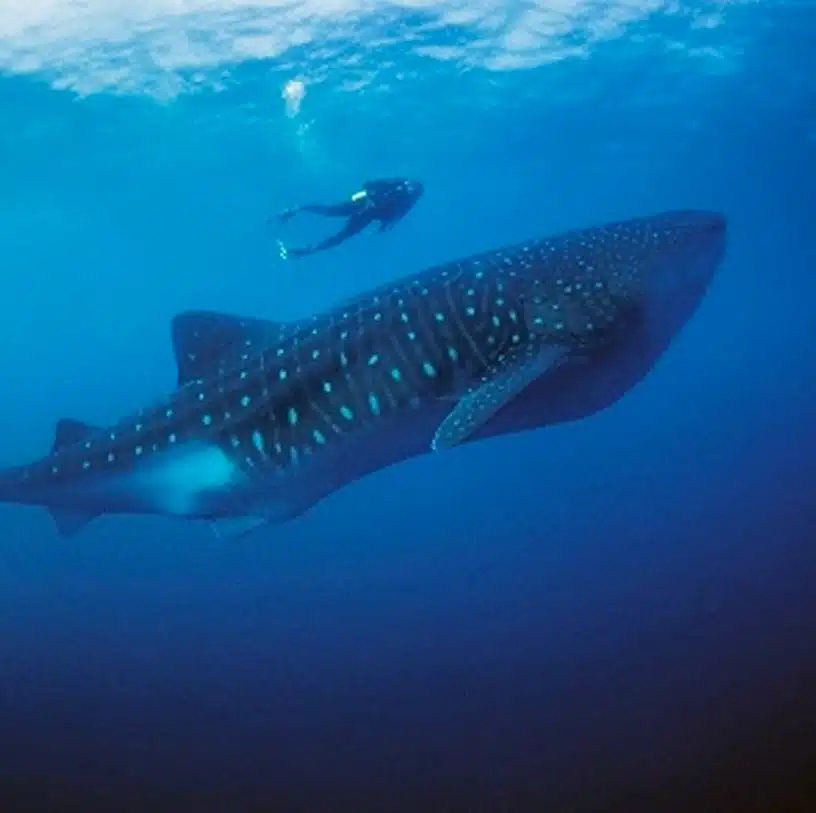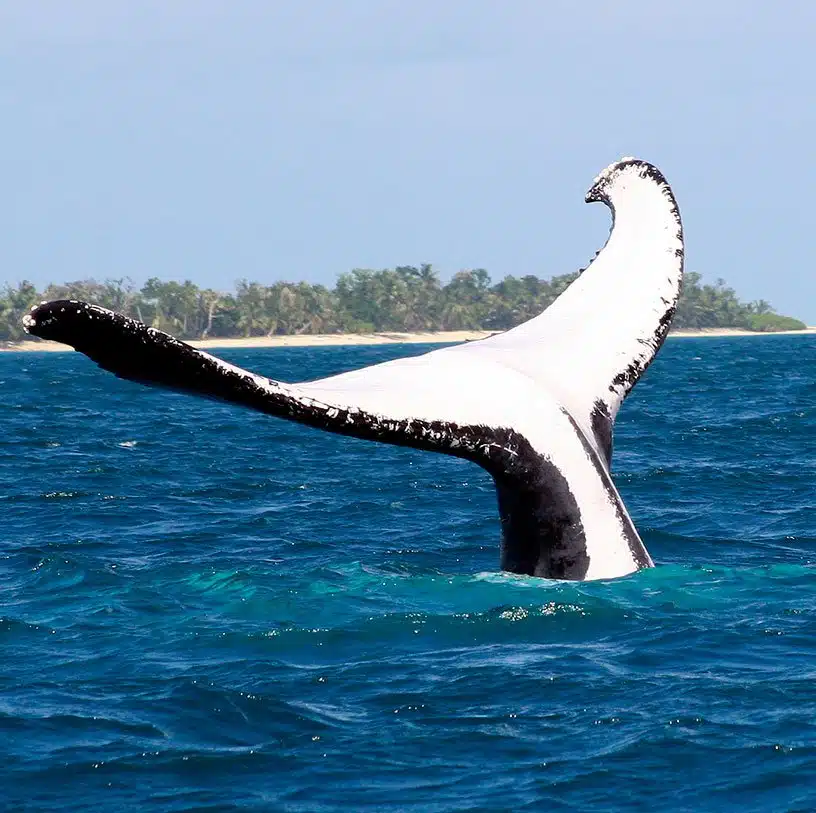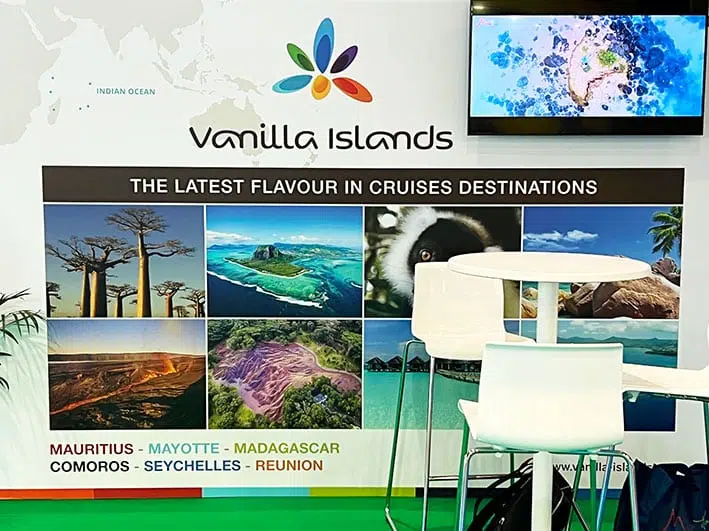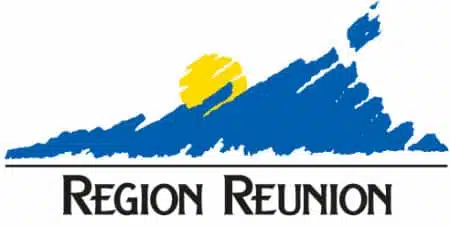This marine mammal migrates in droves during the southern winter months, offering spectacular displays off the Madagascan coast. The perfect opportunity for large numbers of tourists to witness what is an extraordinary and breathtaking event.
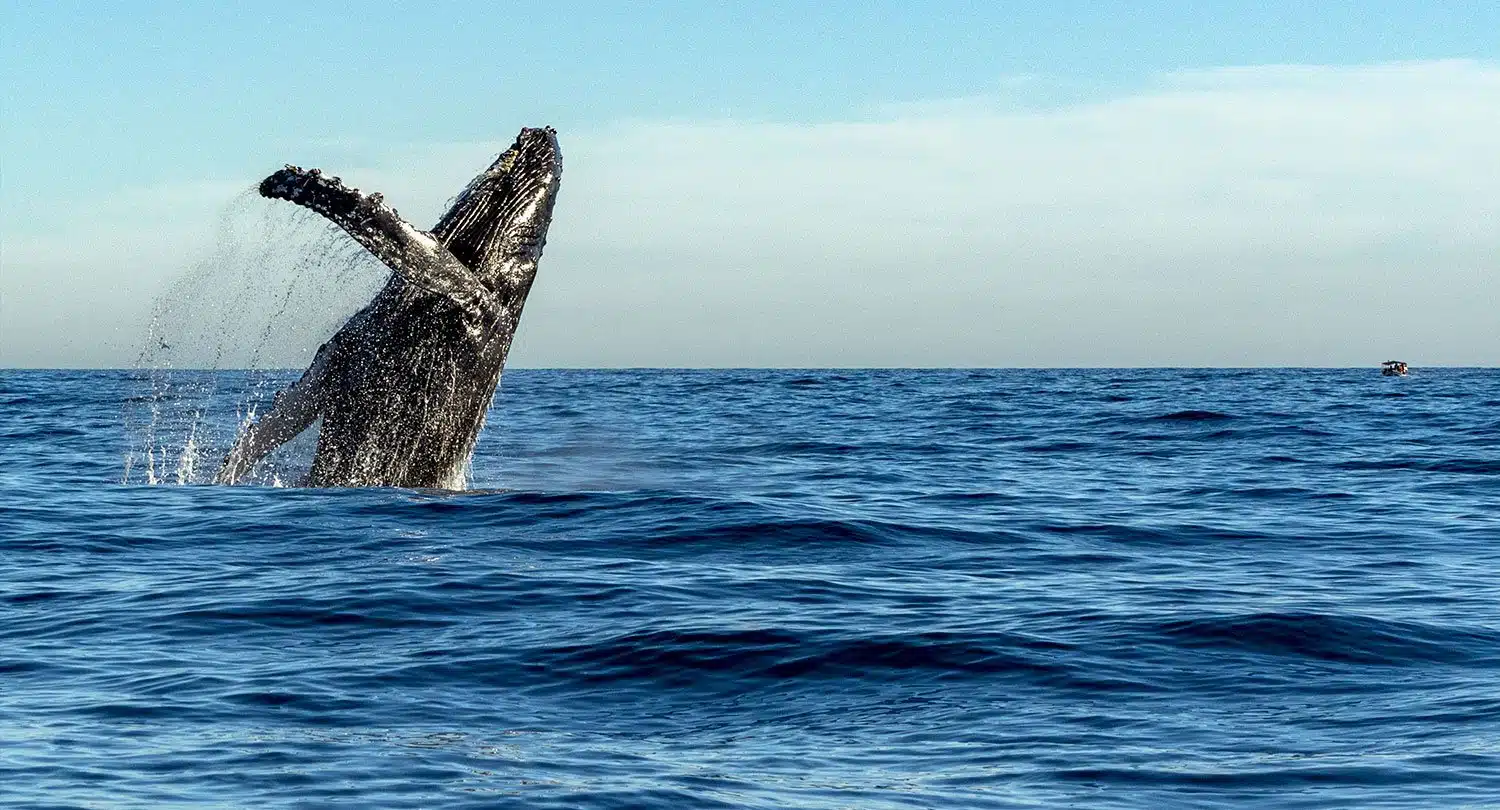
THE MARINE MAMMALS AND HUMPBACK WHALES OF MADAGASCAR
Whilst humpback whales are one of the most studied of the great whales, little is known about their population structure in the southern hemisphere. According to the IUCN, the global population is around 60,000, with the International Whaling Commission estimating that 35,000 of these are found in the southern hemisphere.
The humpback whale measures between 14 and 16 metres in length, with an adult’s weight ranging from 34,000 to 45,000 kg. A distinguishing feature of this cetacean is its long pectoral fins, which can measure up to a third of its body length. They have a small dorsal fin, two thirds down the spine, in front of which is the famous hump after which they are named. Other characteristic features are their white undersides and the wavy rear edges of their tail fins, which have variable colour patterns that run from white to black and form unique patterns. Along with any scarring, these features can be used to identify individual whales.
MADAGASCAR, A BREEDING GROUND
Humpback whales have long migratory routes between their feeding and breeding grounds. They spend the summer months feeding in higher latitudes where the waters are nutritionally rich in krill and shoals of small fish. As autumn moves in to winter, they begin their long journey towards their wintering and breeding grounds that are found in lower latitudes.
The preferred wintering grounds of humpback whales are warm, shallow waters that offer a protected habitat. In winter, therefore, the whales migrate towards tepid, tropical seas, such as those off the coast of Madagascar, where they can mate and give birth.
Females return annually to the same breeding ground to mate and give birth to their young. It is the best time to see young calves imitate their mother’s behavior and take their first ‘baby steps’. Whales live for around thirty years and in the course of their lifetime a female can give birth to more than fifteen calves.
The whale-watching season: From mid-June to September
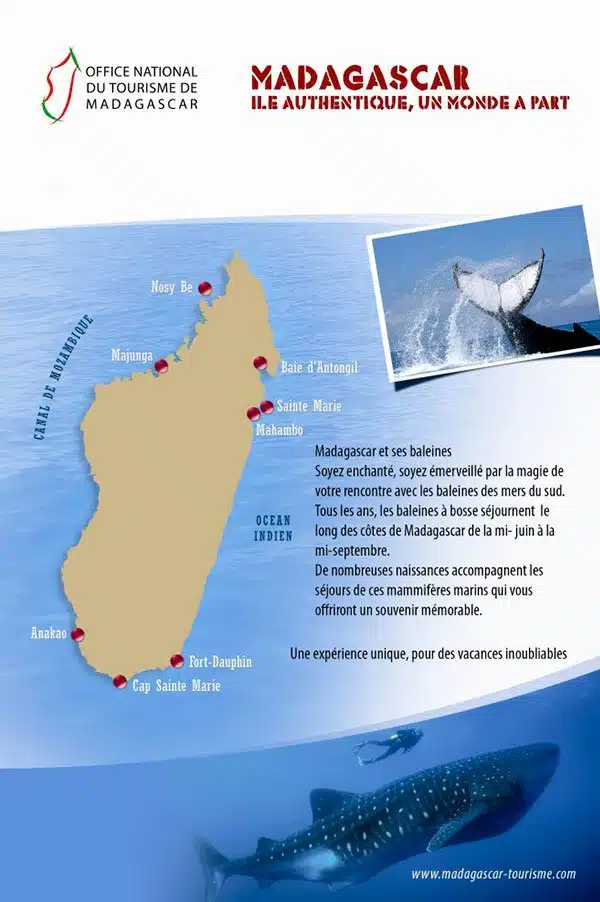
ASSOCIATION CÉTAMADA
Cétamada is a non-profit organisation regulated by Madagascan law that was founded in May 2009.
Its objective is the preservation of marine mammal populations and their Madagascan habitat. In order to meet its goals, the association is committed to sustainable development by including local populations in its projects and by generating long term revenues for the island’s communities.
Its activities are focused on 4 principle courses of action:
- the regulation and promotion of responsible and durable eco-tourism
- education and raising awareness of environmental issues and marine life
- development of community based activities
- scientific research
ENVIRONMENTAL EDUCATION
CétaClub offers a number of activities (land and sea-based) to children from Sainte-Marie that are both fun and educational. The activities take place on Wednesdays, Saturdays and during the school holidays. Approximately 150 children are signed up. Throughout the year, instructors devise awareness raising activities for children from Sainte-Marie that focus on the importance of marine life.
This project is at the heart of the association’s mission: assuring the conservation of Madagascan marine mammals by building awareness over the long-term. To achieve this, suitably adapted, fun activities are held, each designed to increase awareness within the younger generation, encouraging children to become more open-minded and respectful of the environment in which they live.
However, environmental awareness and education is not limited to children. The scientific team regularly holds conferences and workshops on the subject of different Madagascan marine mammals and the issues involved in ensuring their conservation.
Cétamada also invites their national and international partners to participate in interactive exchanges. These meetings are open to the public, whether it be a tourist who wishes to learn more about local biodiversity or a Madagascan student keen to further their studies on biodiversity and the environment. These conferences have been running since 2009 at various locations including Antananarivo, Tamatave, Nosy Be, Tuléar, Diego-Suarze and Sainte-Marie.
COMMUNITY BASED ACTIVITIES
The southern winter migration of humpback whales draws more than 5,000 tourists a year to Sainte-Marie and her surrounds (about 50% of the annual tourist flow), making the area one of top three most popular tourist attractions in Madagascar.
Cétamada is committed to the development of economic activities that promote the marine life of Madagascar and in particular the humpback whale. The association’s community centre has an open door policy for those wish to learn about local craft techniques or perfect their skills. Materials are provided and craftspeople are invited to exhibit their works – clothes, sculptures, paintings, weaving and so forth. Cétamada’s eco-tourist partners also provide exhibition space where merchandise is displayed.
An economic impact study on whale-watching revenues within the maritime zones of the Baie d’Antongil, Sainte-Marie, Nosy Be, Anakao and Cap Sainte-Marie showed that this activity generated 1,825,628USD during the 2008 season. Even though whale-watching and eco-tourism are proactively marketed by different organizations in other Madagascan regions, Sainte-Marie remains one of the principle whale-watching sites.
During visits to local bush villages by our environmental educator, local habitants have the opportunity to learn about a variety of environmental issues and how they can make a difference on a daily basis – waste management, forest preservation, the protection of coral reefs and lagoons, the water table…indeed any subject that impacts on marine life in general.
Even though no waste management system is in place in Madagascar, it is vital the environment be respected and that people are educated as to the consequences of certain habits.
SCIENTIFIC RESEARCH
Being well aware of the need to protect both marine mammals of Madagascar and their habitats, Cétamada is committed to developing the collection of scientific data on the natural sanctuary that is the Indian Ocean. The association is particularly focused on monitoring migrant humpback whales along the entire 5,000 km of coastline.
Je suis un bloc de texte, cliquez sur le bouton \”éditer\” pour me modifier. Lorem ipsum dolor sit amet, consectetur adipiscing elit. Ut elit tellus, luctus nec ullamcorper mattis, pulvinar dapibus leo.
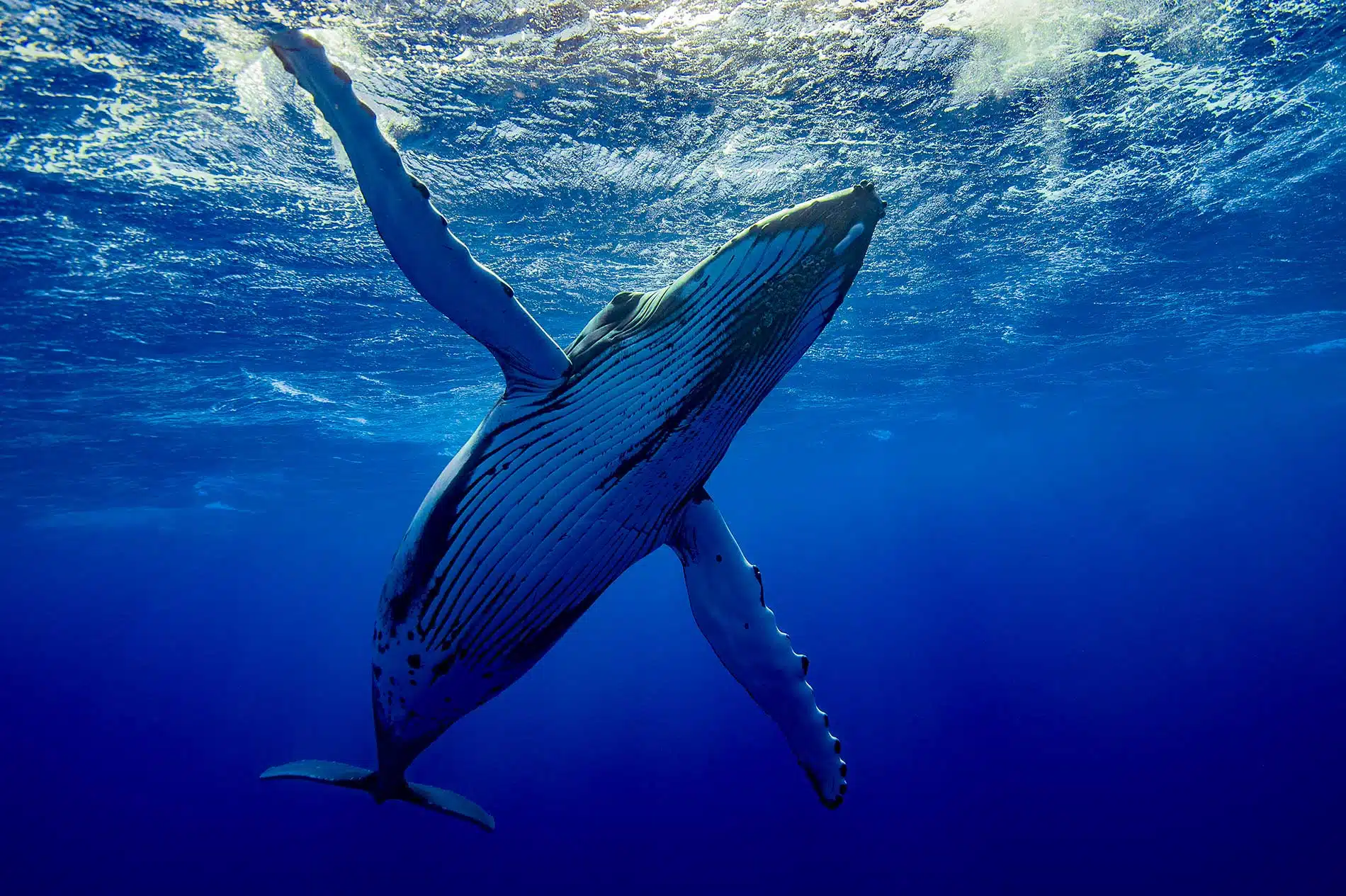
MANAGING ECO-TOURISM
The association has drawn up a code of conduct concerning responsible and respectful marine mammal watching in Madagascar, whether it be humpback whales, dolphins etc. This document clearly sets out an inter-ministerial order drawn up in 2000, which defines regulations on marine mammal watching.
Each year, in partnership with the Ministry of Tourism, the association trains up environmental volunteers who help manage tourist visits organized by operators who work alongside Cétamada as well as collecting scientific data and taking part in community awareness programs.
Based on the island of Sainte-Marie, to the North East of Madagascar, the association is active across the entire Madagascan territory
WHALE-WATCHING SAFARIS
Several operators run whale-watching safaris. They are all trained up by Association Cétamada.
MAHAJANGA
Antsanitia Resort
MAHAMBO
Hôtel La Pirogue
SAINTE-MARIE
Villas de Vohilava
Princesse Bora Lodge
Hôtel Soanambo
Hôtel Maningory
Hôtel Le Libertalia
Hôtel Lakana
Hôtel Boraha Village
Hôtel Baboo Village
Eden Be Lodge
Bora Dive and Research
TULÉAR
Salary Bay
Hôtel Paradisier
Atimoo Plongée


